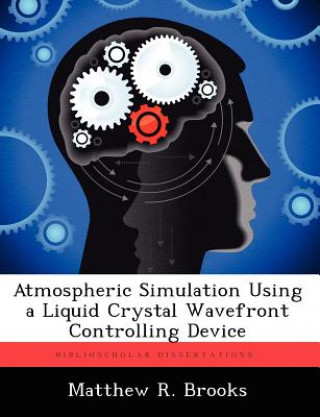
Code: 08141770
Atmospheric Simulation Using a Liquid Crystal Wavefront Controlling Device
by Matthew R Brooks
Test and evaluation of laser warning devices is important due to the increased use of laser devices in aerial applications. In this thesis, an atmospheric aberrating system is developed to enable in lab testing of laser warning de ... more
- Language:
 English
English - Binding: Paperback
- Number of pages: 96
Publisher: Biblioscholar, 2012
- More about this

57.11 €
RRP: 58.25 €
You save 1.14 €

In stock at our supplier
Shipping in 15 - 20 days
You might also like
-

George Stubbs
18.29 € -12 % -

Geography of the Dominion of Canada and Newfoundland. with Ten Maps, Etc.
21.62 € -19 % -

Woman Man'S Equal.
29.81 € -

California and Oregon Trail; Being Sketches of Prairie and Rocky Mountain Life.
31.13 € -19 % -

Martial Odyssey
38.61 € -

Autonomy, Unmanned Ground Vehicles, and the U.S. Army
60.04 € -

Peace and Parsnips
23.14 € -18 % -

Barbers' Company. a Paper Read Before the British Arch Ological Association on October 15th, 1881. Second Edition.
16.87 € -18 % -

Sound Believer. a Treatise of Evangelicall Conversion. Discovering the Work of Christ's Spirit, in Reconciling of a Sinner to God. by Tho. Shepherd, .
34.57 € -

Senior Service College
60.04 € -
![History of Shiplake, Oxon. With allusions to contemporary events in the neighbourhood. [With illustrations.] History of Shiplake, Oxon. With allusions to contemporary events in the neighbourhood. [With illustrations.]](https://media.libris.to/jacket/08045680t.jpg)
History of Shiplake, Oxon. With allusions to contemporary events in the neighbourhood. [With illustrations.]
33.76 € -
![Erinnerungen. [Edited by John Heinrich Fuessli.] Dritter Band Erinnerungen. [Edited by John Heinrich Fuessli.] Dritter Band](https://media.libris.to/jacket/08061398t.jpg)
Erinnerungen. [Edited by John Heinrich Fuessli.] Dritter Band
36.59 € -
![Ismay's Children. [A Novel.] by the Author of Hogan, M. P., Etc. [I.E. May Laffan, Afterwards Harley]. Ismay's Children. [A Novel.] by the Author of Hogan, M. P., Etc. [I.E. May Laffan, Afterwards Harley].](https://media.libris.to/jacket/07985652t.jpg)
Ismay's Children. [A Novel.] by the Author of Hogan, M. P., Etc. [I.E. May Laffan, Afterwards Harley].
24.76 € -19 % -

Mr. Midshipman Easy ... Illustrated, Etc.
27.19 € -18 % -

Treachery
31.53 € -

Transforming the Army Division in an Era of Persistent Conflict
57.11 € -1 % -

Marquis and Merchant.
27.19 € -18 % -

Conversations on Christian Idolatry, in the Year 1791. Published by Theophilus Lindsey, M.A.
20.01 € -19 % -

Assassination of Abraham Lincoln
25.47 € -1 % -
![Vestriad, a Poem. [With Plates.] Vestriad, a Poem. [With Plates.]](https://media.libris.to/jacket/07998325t.jpg)
Vestriad, a Poem. [With Plates.]
28.80 € -18 % -

Survey of Linguistic Theories, 3rd Edition
33.05 € -24 %
Give this book as a present today
- Order book and choose Gift Order.
- We will send you book gift voucher at once. You can give it out to anyone.
- Book will be send to donee, nothing more to care about.
More about Atmospheric Simulation Using a Liquid Crystal Wavefront Controlling Device
You get 143 loyalty points
 Book synopsis
Book synopsis
Test and evaluation of laser warning devices is important due to the increased use of laser devices in aerial applications. In this thesis, an atmospheric aberrating system is developed to enable in lab testing of laser warning devices. This system employs laser light at 632.8 nm from a Helium Neon source and a spatial light modulator(SLM) to cause phase changes using a birefringent liquid crystal material. Before the system can be used, the SLM phase response must be quantified to ensure proper manipulation of index of refraction. Additionally, diffraction from the SLM and real world system scaling are addressed. Once completed, the atmospheric simulator is demonstrated and verified. Control of the SLM is achieved by loading 256 level bitmaps which dictate the desired index of refraction changes(called phase screens). Phase screens are created using a Fourier series technique applied to an atmospheric model in the form of a power spectrum. Five laser propagation scenarios are created, each with a set of screens describing turbulence for a particular case. Outgoing radiation from the SLM is then measured using a CCD target board for intensity and a Shack Hartmann wave front sensor for phase.Comparing system output phase statistics to atmospheric theory reveals a mode rate correlation in all turbulence cases indicating desired performance. Intensity statistics are compared to the log normal distribution governed by the weak fluctuation regime. An error analysis reveals that strong turbulence data matches theory but that weak turbulence data is inconclusive due to measurement precision issues. As an additional check on performance, a wave optics computer simulation is created analogous to the lab bench design. Phase and intensity data affirm lab bench results so that the aberrating SLM system can be operated confidently.
 Book details
Book details
Book category Books in English Society & social sciences Education
57.11 €
- Full title: Atmospheric Simulation Using a Liquid Crystal Wavefront Controlling Device
- Author: Matthew R Brooks
- Language:
 English
English - Binding: Paperback
- Number of pages: 96
- EAN: 9781249584797
- ISBN: 9781249584797
- ID: 08141770
- Publisher: Biblioscholar
- Weight: 186 g
- Dimensions: 246 × 189 × 5 mm
- Date of publishing: 03. October 2012
Trending among others
-

Cambridge IGCSE (R) & O Level Complete Physics: Student Book Fourth Edition
42.15 € -

Cambridge IGCSE (R) & O Level Complete Biology: Student Book Fourth Edition
39.22 € -

Oxford IB Diploma Programme: IB Economics Course Book
62.27 € -

Cambridge IGCSE (R) & O Level Complete Biology: Print and Enhanced Online Student Book Pack Fourth Edition
61.36 € -

Teach Reading With Orton-gillingham
18.90 € -10 % -

Oxford International Primary Science Second Edition: Workbook 4
15.05 € -

Business Partner B1+ Workbook
16.87 € -3 % -

Oxford International Primary Science Second Edition: Student Book 1
26.88 € -

Oxford International Primary Maths Second Edition: Practice Book 2
12.22 € -

Edexcel International GCSE Chemistry Student Book Second Edition
35.37 € -4 % -

Oxford International Primary Maths Second Edition: Practice Book 1
12.22 € -

240 Vocabulary Words Kids Need to Know: Grade 3
11.82 € -17 % -

Oxford International Primary Maths Second Edition: Practice Book 3
13.64 € -

Growth Mindset Classroom-ready Resource Book
16.27 € -28 % -

Cambridge IGCSE (R) & O Level Complete Chemistry: Student Book Fourth Edition
47 € -

geog.2 Workbook
12.53 € -

Oxford IB Diploma Programme: IB Theory of Knowledge Course Book
58.02 € -

KS3 Maths 10-Minute Weekly Workouts - Year 7
8.08 € -8 % -

Blue Book of Grammar and Punctuation: An Easy- to-Use Guide with Clear Rules, Real-World Examples , and Reproducible Quizzes, Twelfth Edition
15.15 € -28 % -

Powerful Teaching: Unleash the Science of Learning
26.17 € -26 % -

ESL/ELL Teacher's Survival Guide: Ready-to-Use Strategies, Tools, and Activities for Teaching En glish Language Learners of All Levels, 2nd Edition
29.81 € -21 % -

Oxford IB Study Guides: Economics for the IB Diploma
47.71 € -

Embodied Teen
21.83 € -15 % -

(ISC) SSCP SG & SSCP Practice Test Kit, 3e
65.10 € -28 % -

AQA A Level Biology Revision Guide
25.57 € -6 % -

UKCAT For Dummies
23.24 € -28 % -

Donny's Unauthorized Technical Guide to Harley Davidson 1936 to Present
46.39 € -19 % -

OET Speaking for Nurses Book 2
11.62 € -2 % -

Cambridge IGCSE (R) & O Level Complete Physics: Print and Enhanced Online Student Book Pack Fourth Edition
58.02 € -

Walk Your Talk; Tools and Theories To Share Nonviolent Communication
29.41 € -

OET Speaking For Nurses Book 1
12.93 € -

Social Skills Activities for Secondary Students wi th Special Needs, Third Edition
26.78 € -20 % -

geog.1 5th edition Workbook Answer Book
56.40 € -

New KS2 English Year 5 Foundation Grammar, Punctuation & Spelling Targeted Question Book w/Answers
8.99 € -5 % -

Making Escape Rooms for Educational Purposes
19 € -

New KS2 English Year 4 Foundation Grammar, Punctuation & Spelling Targeted Question Book w/Answers
8.99 € -5 % -

Cambridge IGCSE (R) & O Level Complete Chemistry: Print and Enhanced Online Student Book Pack Fourth Edition
63.18 € -

Education in the New Age
12.93 € -

Oxford International Primary Maths Second Edition: Practice Book 5
16.57 € -

Oxford IB Diploma Programme: Oxford IB Diploma Programme: IB Mathematics: applications and interpretation Standard Level Enhanced Online Course Book
95.43 € -

OET Preparation
9.70 € -

Business Partner B1 Workbook
17.68 € -8 % -

Speed and Accuracy: Multiplication
8.58 € -

KS3 Maths 10-Minute Weekly Workouts - Year 8
8.08 € -8 % -

Business Partner B2 Workbook
16.87 € -3 % -

Speed and Accuracy: Division
8.58 € -

1000 TRIOS or gapped sentences for Cambridge Advanced and Proficiency Exams
24.25 € -

Pearson Edexcel AS and A level Mathematics Statistics & Mechanics Year 1/AS Textbook + e-book
17.78 € -

Pearson Edexcel International GCSE (9-1) English Language B Student Book
50.54 €
Collection points Bratislava a 2642 dalších
Copyright ©2008-24 najlacnejsie-knihy.sk All rights reservedPrivacyCookies


 15549 collection points
15549 collection points Delivery 2.99 €
Delivery 2.99 € 02/210 210 99 (8-15.30h)
02/210 210 99 (8-15.30h)